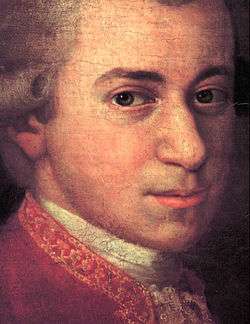String Quintet No. 4 (Mozart)
The String Quintet No. 4 in G minor, K. 516 was written by Wolfgang Amadeus Mozart. Like all of Mozart's string quintets, it is a "viola quintet" in that it is scored for string quartet and an extra viola (two violins, two violas and cello).
The work was completed on May 16, 1787, less than a month after the completion of his grand C major Quintet, K. 515. This would not be the last time that a great pair of C major/G minor works of the same form would be published in close proximity and assigned consecutive Köchel numbers. The following year, the 40th (G minor) and 41st (C major) symphonies (respectively K.550 and K.551) would be completed within a few weeks of each other.
The mood of the piece is dark and melancholic, typical of Mozart's G minor works.
Movements
The work is in four movements:
- I. Allegro
 (G minor, sonata form)
(G minor, sonata form) - II. Menuetto: Allegretto 3
4 (G minor, ternary form, trio in G major) - III. Adagio ma non troppo
 (E-flat major, modified sonata form with no development)
(E-flat major, modified sonata form with no development) - IV. Adagio 3
4 (G minor) - Allegro 6
8 (G major, sonata rondo form)
The first movement is in sonata form with both the first and second themes beginning in G minor.[1] The movement does not resolve to the major key in the recapitulation and has a minor-key ending.
The minuet is placed second and is a minuet in name only as the turbulent G minor theme and heavy third-beat chords make this movement very undancelike. The central trio is in a bright G major.
The third movement in E-flat major is slow, melancholic and wistful, furthering the despair brought forth by the previous movements. Pyotr Ilyich Tchaikovsky said of this movement: "No one has ever known as well how to interpret so exquisitely in music the sense of resigned and inconsolable sorrow."
The start of the fourth movement is not the typical quick-tempo finale, but a slow aria back in the home key of G minor. It is a dirge or lament that is even slower than the previous movement. The music wallows in this dark area for a few minutes before reaching an ominous pause. At this point, Mozart launches into the ebullient G major Allegro which creates a stark contrast between it and the movements that preceded it. Critics have often questioned how such an insouciant and carefree finale could be tacked on after three-plus movements of intense pathos,[1] even though it conforms perfectly to the Classical understanding of a finale as resolving everything that preceded it.[2]
Media
 |
String Quintet No. 4, K. 516
1. Allegro
2. Menuetto: Allegretto
3. Adagio ma non troppo
4. Adagio - Allegro
Performed by Roxana Pavel Goldstein, Elizabeth Choi, violins; Elias Goldstein, Sally Chisholm, violas; Jocelyn Butler, cello |
| Problems playing these files? See media help. | |
References
External links
- Quintett in g: Score and critical report (German) in the Neue Mozart-Ausgabe
- BBC Discovering Music (browse for .ram file for this work)
- Performance of quintet by the Orion Quartet and Ida Kavafian from the Isabella Stewart Gardner Museum in MP3 format
- String Quintet No. 4: Scores at the International Music Score Library Project
- Analysis of the quintet based on the Kübler-Ross model of grief and loss
- Analysis of hemiola in the minuet of this work
- Michael Lorenz, "An Interpretation Issue in the Slow Movement of Mozart's String Quintet K. 516" (Vienna 2014)
